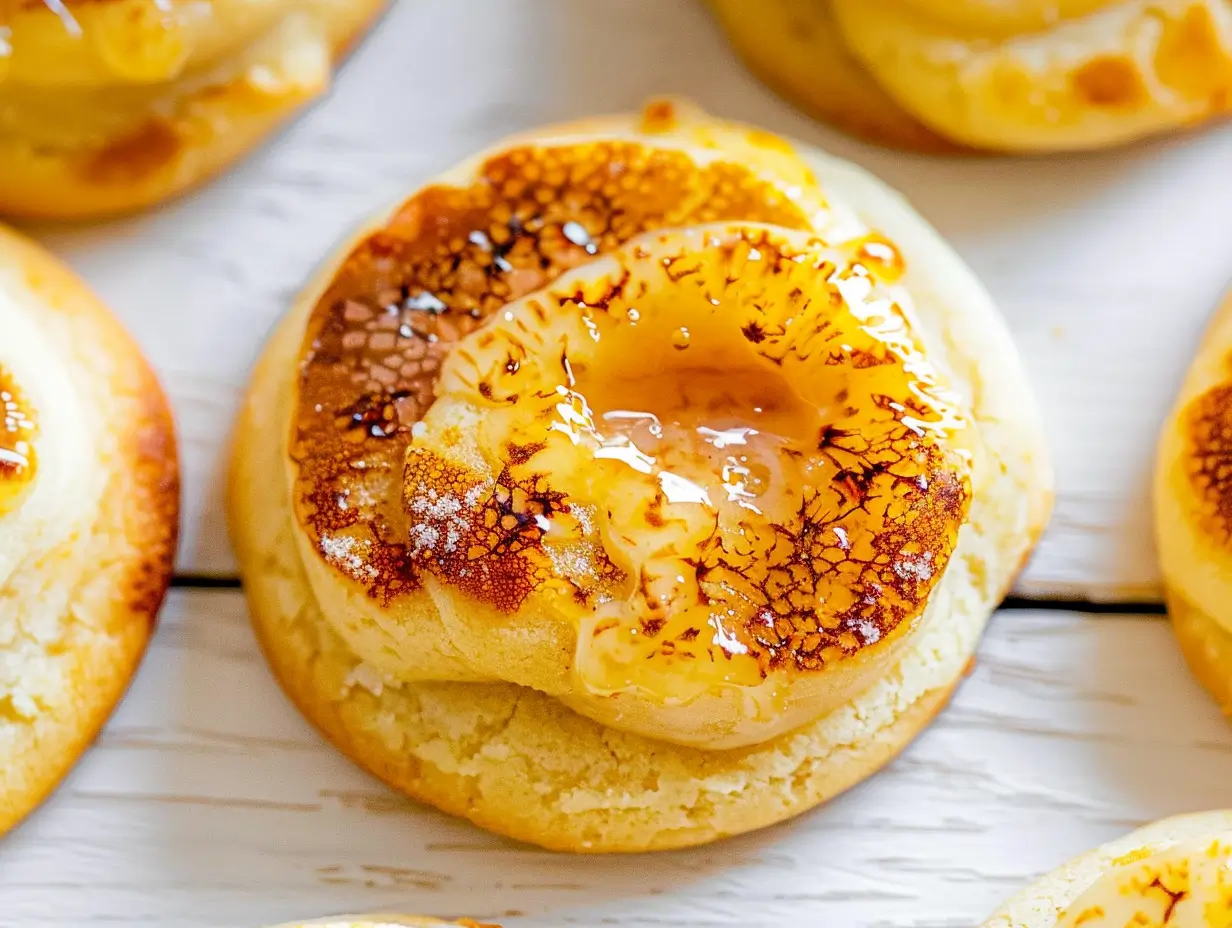If you love the rich, caramelized top of a classic crème brûlée and the softness of a perfectly baked cookie, you’re in for a treat! These Crème Brûlée Cookies combine the best of both worlds: a soft, buttery sugar cookie topped with creamy frosting and a crunchy caramelized sugar layer. Each bite offers a delightful contrast of textures and flavors, making them the perfect indulgence for holidays, special occasions, or just when you want to impress.
Let’s dive into the step-by-step guide to creating these decadent cookies!
Ingredients:
- ½ cup unsalted butter, softened
- ½ cup canola or vegetable oil
- ½ cup granulated sugar
- ½ cup confectioners’ sugar
- 1 large egg
- 1 teaspoon vanilla extract
- 1 teaspoon almond extract
- 2 ¼ cups all-purpose flour
- ½ teaspoon baking soda
- ½ teaspoon cream of tartar
- ½ teaspoon salt
For the Frosting:
- 8 oz cream cheese, softened
- 6 tablespoons unsalted butter, softened
- 2 ½ cups confectioners’ sugar
For the Caramelized Topping:
- Granulated sugar (about 1/2 to 1 teaspoon per cookie)
Directions:
Step 1: Make the Cookie Dough
In the bowl of a stand mixer (or using a hand mixer), combine butter, oil, granulated sugar, and confectioners’ sugar. Beat on medium-high speed for about 4 minutes until the mixture is creamy and well-combined.
Add the egg, vanilla extract, and almond extract to the butter-sugar mixture, and mix until combined.
In a separate bowl, whisk together the flour, baking soda, cream of tartar, and salt. Gradually add the dry ingredients to the wet mixture, beating on low speed until just combined.
Step 2: Shape the Dough
Using a 2-tablespoon scoop, portion the dough into 20 equal-sized balls. Roll each piece into a ball and flatten them slightly with your hands to form cookie shapes.
Step 3: Chill the Dough
Place the dough balls on a baking sheet or plate, cover, and chill them in the refrigerator for at least 2 hours. This step helps prevent the cookies from spreading too much while baking. You can also chill the dough for up to 7 days if making ahead.
Step 4: Preheat the Oven
Preheat your oven to 350°F (175°C). Line a baking sheet with parchment paper or a Silpat baking mat to prevent sticking.
Step 5: Bake the Cookies
Place the chilled dough balls on the prepared baking sheet, spacing them about 2 inches apart. Bake for 8-9 minutes, or until the edges are set but the centers remain slightly glossy. The cookies should be soft in the middle when you take them out, as they will continue to firm up as they cool.
Let the cookies cool on the baking sheet for about 5 minutes before transferring them to a wire rack to cool completely.
Step 6: Make the Cream Cheese Frosting
In a clean bowl, beat the softened cream cheese and butter together until creamy and smooth. Gradually add the confectioners’ sugar and beat until fully combined and smooth.
Step 7: Frost the Cookies
Once the cookies are completely cooled, spread about 2-3 teaspoons of cream cheese frosting on each cookie. Smooth it out with a small spatula or butter knife.
Step 8: Brûlée the Tops
Sprinkle 1/2 to 1 teaspoon of granulated sugar on top of the frosted cookies. Using a kitchen torch, carefully brûlée the sugar until it melts and caramelizes into a crispy, golden layer. Be sure to hold the torch at a safe distance and move it in small circles to evenly caramelize the sugar without burning it.
Serving and Storage Tips:
- Serving: These cookies are best enjoyed fresh when the sugar crust is at its crispiest. Serve them as a sweet treat after dinner or alongside a cup of coffee for a fancy snack.
- Storage: Store the cookies in an airtight container in the refrigerator for up to 5 days. To enjoy them at their best, let them come to room temperature before serving.
- Freezing: You can freeze the unfrosted cookies for up to 2 months. Thaw them overnight in the fridge, then frost and brûlée when ready to serve.
Helpful Notes:
- Chilling the Dough: Don’t skip the chilling step! It helps the cookies maintain their shape during baking and prevents them from spreading too much. Chilling also enhances the flavor and texture of the dough.
- Caramelizing the Sugar: If you don’t have a kitchen torch, you can try placing the cookies under the broiler for a few seconds. Keep a close eye on them to prevent burning.
- Frosting: Make sure the cookies are completely cool before frosting, or the frosting will melt and become runny.
Tips from Well-Known Chefs:
- Christina Tosi, founder of Milk Bar, suggests adding a pinch of sea salt to the sugar before caramelizing for a salted caramel effect that balances the sweetness.
- Jacques Pépin recommends using superfine or caster sugar for brûlée topping as it caramelizes more evenly and quickly than regular granulated sugar.
- Martha Stewart emphasizes using a steady hand with the torch, moving it in small circles to evenly brûlée the sugar and avoid scorching the frosting underneath.
Frequently Asked Questions (FAQs):
1. Can I use margarine instead of butter?
While margarine can be used, butter gives the cookies a richer flavor. If you substitute, expect a slight difference in taste and texture.
2. What if I don’t have a kitchen torch?
If you don’t have a kitchen torch, you can use the broiler in your oven to caramelize the sugar. Just place the frosted cookies under the broiler for a few seconds, watching them closely to prevent burning.
3. Can I make these cookies ahead of time?
Yes! You can make the dough and chill it for up to 7 days before baking. The baked cookies can be stored unfrosted for a few days or frozen for later use.
4. How do I soften cream cheese quickly?
To soften cream cheese quickly, you can microwave it in short bursts (5-10 seconds) until soft, or leave it at room temperature for about 30 minutes before using.
5. Can I use different extracts?
Yes! You can swap out almond extract for something like lemon, coconut, or orange extract to change the flavor profile of the cookies.
6. Can I use low-fat cream cheese?
Full-fat cream cheese gives the best texture and flavor, but you can use low-fat cream cheese if you prefer. Keep in mind that the frosting may be slightly less rich.
7. What type of sugar works best for brûléeing?
Granulated sugar works perfectly, but you can also use superfine sugar for a quicker, more even caramelization.
8. How do I keep the cookies soft?
To keep your cookies soft, store them in an airtight container at room temperature or in the fridge. Adding a slice of bread to the container helps keep them moist.
9. Can I freeze the frosting?
Cream cheese frosting can be frozen for up to 2 months. Thaw it in the fridge overnight and re-whip before using to restore its creamy texture.
10. Can I use a gluten-free flour substitute?
Yes, you can use a 1:1 gluten-free flour substitute for this recipe. Just make sure it’s a blend designed for baking to ensure the right texture.
These Crème Brûlée Cookies are a perfect balance of soft, chewy, and crunchy. With their creamy frosting and caramelized sugar topping, they bring the luxurious flavors of crème brûlée into a delicious handheld treat. Whether you’re baking them for a special occasion or a casual dessert, these cookies are sure to impress! Enjoy!





